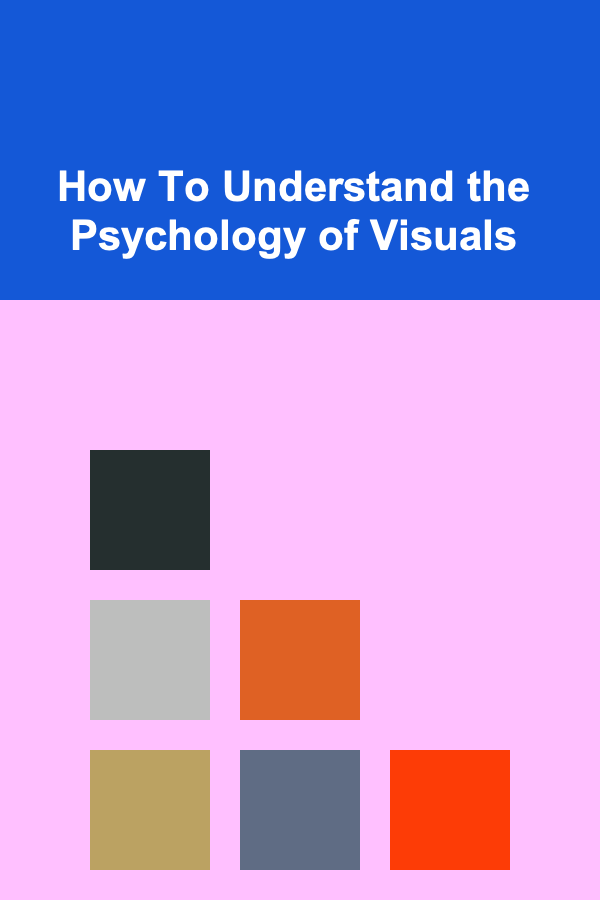
How To Understand the Psychology of Visuals
ebook include PDF & Audio bundle (Micro Guide)
$12.99$10.99
Limited Time Offer! Order within the next:

Visuals are an integral part of human communication. We live in a world where images, colors, shapes, and designs surround us at all times, influencing our thoughts, emotions, and behaviors. Understanding the psychology of visuals is essential in various fields, including marketing, design, branding, art, and even daily communication. Visuals can convey messages without words, evoke emotional responses, and influence decisions.
In this article, we will explore the psychology behind visuals, how they impact human perception, and the factors that make visuals compelling. We will dive into the science of how the brain processes visuals, the impact of colors, shapes, and designs, and how these elements are used to evoke specific emotional and cognitive responses.
The Power of Visuals: Why We Are Drawn to Them
Humans are inherently visual creatures. Studies suggest that approximately 90% of the information we process is visual. Our brains are wired to quickly interpret visual information because it helps us make decisions faster. Evolutionary psychologists believe that visual perception has been crucial for survival --- spotting danger, finding food, or navigating our environment all depended on visual cues.
Today, the ability to process visuals has evolved from a survival mechanism to a critical aspect of communication. In a world full of distractions, visuals grab our attention and deliver messages instantly. Whether it's a product advertisement, a social media post, or a website design, visuals play a significant role in how we engage with content and the decisions we make.
Cognitive Processing of Visuals
The human brain processes visuals differently than text or auditory information. When we look at an image, the brain's visual cortex, located at the back of the brain, processes the image first. This area is specialized in interpreting shapes, colors, and movement. The brain then connects the visual input with emotions, memories, and experiences stored in different parts of the brain.
One of the reasons visuals are so powerful is their ability to bypass the cognitive effort needed for reading or listening. A well-designed visual can evoke an emotional reaction almost instantly, whereas reading or listening requires more time and attention. This is why visuals are often used in advertising, branding, and media to create a strong initial impact.
The Science of Color: How Colors Affect Perception
Color psychology is one of the most significant aspects of visual design. Different colors can evoke a wide range of emotions and associations. From an early age, humans learn to associate colors with specific meanings or feelings. For instance, red is often associated with danger, love, or passion, while blue is linked with calmness and trust.
The Emotional Impact of Colors
The emotional responses to colors are deeply rooted in both biology and cultural associations. For example:
- Red: Known for its intensity, red can evoke feelings of excitement, passion, and urgency. It can also raise heart rates and blood pressure, which is why it is often used in sales promotions or emergency warnings.
- Blue: A color associated with calmness, trust, and professionalism. It can make individuals feel relaxed and safe. This is why many corporations, especially in finance or healthcare, use blue in their branding.
- Yellow: A bright and cheerful color that can stimulate feelings of happiness and optimism. However, in excess, yellow can also evoke anxiety or frustration, which is why it is used sparingly in design.
- Green: Often associated with nature, growth, and health. Green is calming and refreshing, and it is frequently used in brands related to eco-friendliness and well-being.
- Black: A powerful color linked to sophistication, luxury, and mystery. It can also signify authority and elegance. High-end brands often use black to convey a sense of exclusivity.
- White: Symbolizing purity, simplicity, and clarity, white is frequently used in minimalist designs. It can create a sense of space and cleanliness.
Cultural Influences on Color Perception
While the emotional responses to colors are somewhat universal, cultural differences can significantly influence how colors are perceived. For example, while white is associated with purity and weddings in many Western cultures, it is often linked to mourning and funerals in some Eastern cultures.
The Role of Color in Branding
Brands use color strategically to influence consumer perceptions and behavior. For instance, McDonald's uses red and yellow in its branding because these colors are associated with appetite stimulation, energy, and excitement. On the other hand, companies like Facebook and LinkedIn use blue to create a sense of trust and professionalism.
Marketers and designers spend significant time selecting the right colors for their branding because color can make or break a product's identity. A successful visual identity relies on understanding the emotional impact of colors and aligning them with the brand's values and target audience.
The Psychology of Shapes and Patterns
Beyond color, the shapes and patterns used in visuals also play a crucial role in how we perceive and respond to images. Shapes can evoke specific emotions and even influence our behavior.
The Power of Geometric Shapes
Geometric shapes, such as circles, squares, and triangles, each carry their own psychological associations:
- Circles: Circles are associated with unity, wholeness, and infinity. They have no beginning or end, making them perfect for conveying a sense of completeness or harmony. Circles are often used in logos to create a feeling of inclusiveness or continuity.
- Squares/Rectangles: These shapes evoke feelings of stability, order, and reliability. Squares are commonly used in designs that aim to convey trustworthiness, such as corporate logos or product packaging.
- Triangles: Triangles can symbolize strength, direction, and dynamism. They can also create a sense of tension or instability, depending on their orientation. For example, an upward-pointing triangle can signify growth, while a downward-pointing one might convey instability or danger.
The Impact of Organic and Asymmetrical Shapes
While geometric shapes convey order and predictability, organic and asymmetrical shapes can evoke feelings of creativity, fluidity, and movement. These shapes are often used in artistic designs or branding that seeks to stand out and appear innovative.
Curves, flowing lines, and irregular shapes are associated with nature and organic forms, making them appear more human and approachable. Asymmetry in design can also create visual interest and draw the viewer's attention to specific areas of the composition.
Patterns and Repetition
Patterns are another crucial element of visual psychology. Repetition of shapes, colors, or lines can create a sense of rhythm and harmony. In some cases, repetition can also make an image or design feel overwhelming or monotonous if overdone.
Patterns are often used in advertising and branding to create recognition. For example, the repeated use of a logo or a specific color pattern helps reinforce the brand's identity in the consumer's mind.
Visual Hierarchy: Organizing Information for Impact
One of the most critical aspects of visual psychology is how information is presented to the viewer. Visual hierarchy refers to the arrangement of elements in a design to guide the viewer's attention in a specific order. It is about ensuring that the most important elements stand out and that the viewer can quickly grasp the message or content.
Principles of Visual Hierarchy
- Size and Scale: Larger elements typically attract more attention, so making certain elements larger than others can help prioritize them. For example, headlines are often larger than body text to make them more noticeable.
- Contrast: High contrast between elements can draw attention to specific areas of a design. For instance, using contrasting colors or varying the brightness between elements can make certain aspects of a visual pop.
- Spacing and Proximity: The spacing between elements affects how they are perceived. Elements that are close together are perceived as related, while those farther apart are seen as separate. Proper use of spacing can help guide the viewer's eye across the design in a natural, logical flow.
- Alignment: Proper alignment of elements helps create order and structure within a design. Misalignment can create a sense of chaos and disorganization, which can distract or confuse the viewer.
- Color and Emphasis: Using a distinct color to highlight important information can help make that element stand out in a visual hierarchy. For example, a call-to-action button in a bright color like red or orange will attract attention and prompt action.
Visual Flow and the Rule of Thirds
One way to guide the viewer's eye is through the concept of visual flow. Designers often use the rule of thirds, which divides a design into nine equal parts, with important elements placed along the lines or at the intersections. This creates balance and guides the viewer's eye in a natural progression.
By strategically using these principles of visual hierarchy, designers can ensure that the viewer's experience is seamless and intuitive. Effective visual hierarchy ensures that the most important message or action is easily accessible and stands out.
The Role of Visuals in Emotional and Behavioral Responses
Visuals are not just about aesthetics; they can profoundly affect our emotional and behavioral responses. In marketing, design, and even art, visuals are intentionally crafted to evoke specific emotions that lead to desired actions.
Emotional Responses to Visuals
Certain visuals can trigger emotional responses based on their design elements. For instance, images of nature may evoke feelings of calm and serenity, while images of people may evoke empathy or connection. The composition of the visual, the colors used, and the overall mood can all influence how a person feels.
- Positive Emotions: Bright, vibrant colors and uplifting imagery often evoke positive emotions such as joy, happiness, or excitement. These visuals are often used in advertisements for entertainment, travel, and leisure products.
- Negative Emotions: Darker colors and images that depict sadness, fear, or tension can evoke negative emotions. These types of visuals might be used to create urgency or convey seriousness, such as in public health warnings or advertisements for crisis-related products.
Behavioral Responses: Call to Action
Visuals are frequently used in marketing to trigger specific behavioral responses, such as purchasing a product, signing up for a service, or clicking on a link. The design of the visual --- its color, placement, and call-to-action --- plays a critical role in converting passive viewers into active participants.
For instance, a well-designed ad with a contrasting call-to-action button (e.g., "Buy Now" or "Learn More") can prompt the viewer to take immediate action. These buttons are often placed at strategic points in a visual hierarchy to make them stand out and grab attention.
Conclusion
Understanding the psychology of visuals is essential for creating designs, advertisements, and artworks that effectively communicate messages, evoke emotions, and influence behaviors. By leveraging principles like color psychology, shape interpretation, visual hierarchy, and emotional triggers, designers and marketers can create visuals that resonate with their target audience.
As visuals continue to dominate our digital and physical environments, their impact on human behavior and perception will only grow. By continuing to study the psychology of visuals, we can unlock new ways to create more engaging and effective communication through design. Whether it's for business, art, or everyday communication, understanding the psychological power of visuals can help us better connect with and influence those around us.

How to Make Your Home Feel Bigger with Smart Renovations
Read More
How to Manage Seasonal Fitness Equipment Changes
Read More
How to Use Clear Storage Boxes for Easy Visibility
Read More
The Cloud Systems Engineer's Guide: Building Scalable and Secure Cloud Solutions
Read More
The Comprehensive Guide to Video Post-Production: A Job-Specific Handbook for Video Editors
Read More
How to Start Collecting Rare Japanese Gashapon Toys
Read MoreOther Products

How to Make Your Home Feel Bigger with Smart Renovations
Read More
How to Manage Seasonal Fitness Equipment Changes
Read More
How to Use Clear Storage Boxes for Easy Visibility
Read More
The Cloud Systems Engineer's Guide: Building Scalable and Secure Cloud Solutions
Read More
The Comprehensive Guide to Video Post-Production: A Job-Specific Handbook for Video Editors
Read More